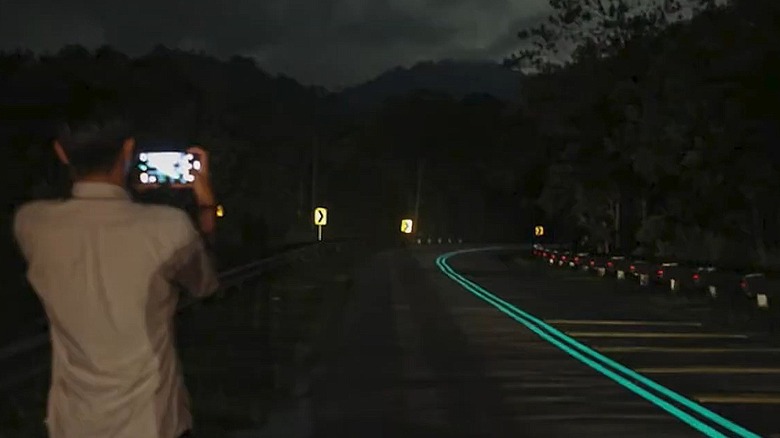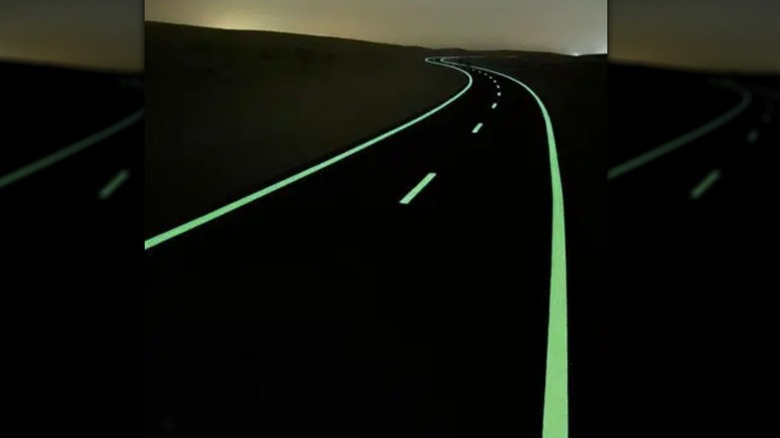Malaysia's Futuristic Glow In The Dark Road Test Failed: Here's Why
When scientists discuss photoluminescence, it is typically within the context of natural phenomenon like bioluminescent waves or potentially revolutionary inventions like glow-in-the-dark wood. Rarely is bright coloring seen as a public safety tool for roads. However, in 2023, Malaysia looked to do just that when it painted a stretch of rural road with photoluminescent paint. The futuristic paint job brought critical street lighting to a country in desperate need of road safety infrastructure, where an accident occurs roughly every 50 seconds, with fatalities occurring every two hours.
Although the luminescent paint earned rave reviews at its onset, it has since suffered from feasibility concerns, with politicians citing cost and durability problems that made expanding the project impractical. Just over a year after its rollout, Malaysian authorities have shelved the project's expansion plans. Malaysia is only one of several countries looking at photoluminescent paint to bolster road safety. Nearly a decade ago, the Netherlands used glow-in-the-dark paint to line roughly 100 kilometers of road outside Amsterdam, but found that the paint delivered inconsistent levels of light due to heavy rainfall.
More recently, trials in Australia and Ireland have sought to test the feasibility of such road markings. These programs seek to find a more permanent, energy-saving alternative to traditional street lights, particularly for rural areas where electricity infrastructure is in short supply. Malaysia's recent experiment provides both a blueprint and a warning for those looking to deploy such technologies, offering a window into the constraints governments face as they seek innovative infrastructure solutions.
The failure of Malaysia's glowing road project
Malaysia's effort to use photoluminescent paint rather than traditional streetlights to increase visibility offered several advantages. For one, the paint fared well in both rainy and foggy conditions, with luminescence lasting up to 10 hours regardless of weather conditions. Glow-in-the-dark paint has also been seen as an environmentally sustainable option that doesn't require complex electrical infrastructure. Increasing road visibility is an essential part of the country's quest to expand the safety of its roadways, and the project was seen as an innovative way to bring light to rural areas known for frequent power outages.
Initially, Malaysia confined its new road lines to select parts of the rural Selangor and Johor regions, with planners expecting to extend the practice across the region. However, price was a major inhibiting factor, as the photoluminescent paint cost roughly 20 times that of standard white markings. Furthermore, the Malaysian Institute of Road Safety Research questioned the paint's durability in Malaysia's humid climate. Such findings paralleled those of the International Journal of Pavement Research and Technology, which estimated that photoluminescent paint would need to be reapplied as frequently as every 18 months in tropical environments. Ultimately, these cost and durability concerns doomed the project.
A bright future for photoluminescent paint?
Despite Malaysia's road test failing, other countries and companies continue to experiment with the technology, with mixed results. The Netherlands debuted photoluminescent paint as early as 2014. Unfortunately, the paint degraded in the rain, leading to a pause in the program. Despite the setback, several European companies have continued to pursue the technology.
In fact, the French company behind Malaysia's glowing road projects, LuminoKrom, has applied its luminescent paint to bike paths, bridges, roads, and industrial sites across the globe, including in France, Colombia, Japan, and India. Irish manufacturer Luminousflux is another notable firm looking to expand the technology's usage in Europe, with trials underway in Sligo, Ireland. Photoluminescent paint is also gaining traction in Australia, where the government of New South Wales began a six-month trial of glow-in-the-dark roads on a dangerous hairpin turn, south of Sydney.
According to local authorities, 125 near-miss accidents were recorded on the turn in the first half of 2024 alone. Per the Australian government, the Glow Road technology used in the trial has undergone rigorous testing to ensure that it will stand up to Australia's unique climate conditions. The trial is expected to run for six months, after which the New South Wales government will decide whether to expand its usage across the region.


